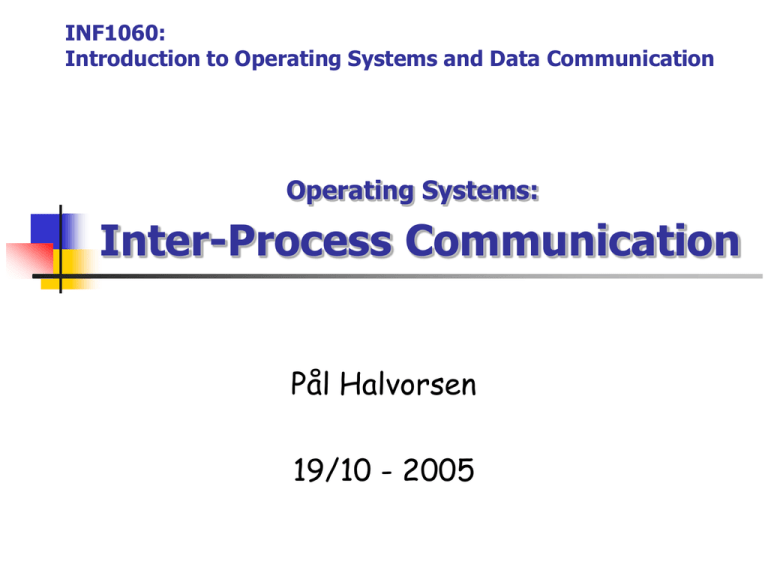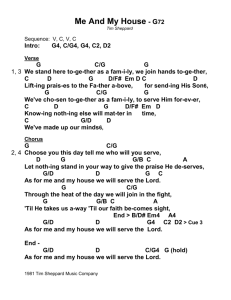INF1060: Introduction to Operating Systems and Data Communication
advertisement

INF1060:
Introduction to Operating Systems and Data Communication
Operating Systems:
Inter-Process Communication
Pål Halvorsen
19/10 - 2005
Big Picture
machine
signals pipes
process A
process B
inter-process
communication
communication?
INF1060 – introduction to operating systems and data communication
2005 Kjell Åge Bringsrud & Pål Halvorsen
Message Passing
What is message-passing for?
communication across address spaces and protection domains
synchronization
Generic API
send( dest, &msg )
recv( src, &msg )
What should the “dest” and “src” be?
pid
file: e.g., a (named) pipe
port: network address, pid, etc
no src: receive any message
What should “msg” be?
need both buffer and size for a variable sized message
INF1060 – introduction to operating systems and data communication
2005 Kjell Åge Bringsrud & Pål Halvorsen
Direct Communication
Must explicitly name the sender/receiver (“dest” and “src”) processes
Several buffers
at the receiver
more than one process may send messages to the receiver
to receive from a specific sender, it requires searching through the whole buffer
at each sender
a sender may send messages to multiple receivers
INF1060 – introduction to operating systems and data communication
2005 Kjell Åge Bringsrud & Pål Halvorsen
Indirect Communication
“dest” and “src” are a shared (unique) queue
Use a shared queue to allow many-to-many communication
requires open/close a mailbox before using it
Where should the buffer be?
a buffer and its mutex and conditions should be at the mailbox
INF1060 – introduction to operating systems and data communication
2005 Kjell Åge Bringsrud & Pål Halvorsen
Mailboxes
Mailboxes are implemented as message queues sorting
messages according to FIFO
messages are stored as a sequence of bytes
system V IPC messages also have a type
sending messages: msgsnd ( Qid, buf, size, flags )
receiving messages: msgrcv ( Qid, buf, size, type, flags )
INF1060 – introduction to operating systems and data communication
2005 Kjell Åge Bringsrud & Pål Halvorsen
Mailboxes
Example:
msgsnd(A,
msgrcv(B,
, ...)
, ...)
A
B
C
D
...
OS-kernel
INF1060 – introduction to operating systems and data communication
2005 Kjell Åge Bringsrud & Pål Halvorsen
Pipes
Classic IPC method under UNIX:
> ls -l | more
shell runs two processes ls and more which are linked via a pipe
the first process (ls) writes data (e.g., using write) to the pipe and
the second (more) reads data (e.g., using read) from the pipe
the system call pipe( fd[2] )
creates one file descriptor for reading
(fd[0]) and one for writing (fd[1])
- allocates a temporary inode and a
memory page to hold data
ls
INF1060 – introduction to operating systems and data communication
struct pipe_inode_info {
wait_queue_head_t wait;
char *base;
unsigned int len;
unsigned int start;
unsigned int readers, writers;
unsigned int waiting_readers, waiting_writers;
unsigned int r_counter, w_counter;
}
52
1
more
2005 Kjell Åge Bringsrud & Pål Halvorsen
Pipe Example
#include <unistd.h>
#include <stdio.h>
char *msg = "hello";
main()
{
char inbuf[MSGSIZE];
int p[2];
pid_t pid;
/* open pipe */
if (pipe(p) == -1) { perror("pipe call error"); exit(1); }
switch( pid = fork() ) {
case -1: perror("error: fork call");
exit(2);
case 0:
close(p[0]); /* close the read end of the pipe */
write(p[1], msg, MSGSIZE);
printf(“Child: %s\n", msg);
break;
default: close(p[1]); /* close the write end of the pipe */
read(p[0], inbuf, MSGSIZE);
printf("Parent: %s\n", inbuf);
wait(0);
}
exit(0);
}
INF1060 – introduction to operating systems and data communication
2005 Kjell Åge Bringsrud & Pål Halvorsen
Mailboxes vs. Pipes
Are there any differences between a mailbox and a pipe?
Message types
Buffer
pipes – one or more pages storing messages contiguously
mailboxes – linked list of messages of different types
Termination
mailboxes may have messages of different types
pipes do not have different types
pipes exists only as long as some have open the file descriptors
mailboxes must often be closed
More than two processes
a pipe often (not in Linux) implies one sender and one receiver
many can use a mailbox
INF1060 – introduction to operating systems and data communication
2005 Kjell Åge Bringsrud & Pål Halvorsen
Shared Memory
Shared memory is an efficient and fast way for processes to
communicate
multiple processes can attach a segment of physical memory to their
virtual address space
if more than one process can access segment, an outside protocol or
mechanism (like semaphores) should enforce consistency/avoid collisions
create a shared segment: shmget( key, size, flags )
attach a shared segment: shmat( shmid, *shmaddr, flags )
detach a shared segment: shmdt( *shmaddr )
control a shared segment: shmctl( … )
INF1060 – introduction to operating systems and data communication
2005 Kjell Åge Bringsrud & Pål Halvorsen
Shared Memory Example
#include
#include
#include
#include
<sys/types.h>
<sys/ipc.h>
<sys/shm.h>
<stdio.h>
#define SHMSZ
27
main()
{
int shmid;
key_t key;
char c, *shm, *s;
#include
#include
#include
#include
#define SHMSZ
27
main()
{
int shmid;
key_t key;
char *shm, *s;
key = 5678; /* selected key */
key = 5678; /* selected key by server */
/* Create the segment.*/
if ((shmid = shmget(key,SHMSZ,IPC_CREAT | 0666)) < 0)
{
perror("shmget"); exit(1);
}
/* Locate the segment. */
if ((shmid = shmget(key,SHMSZ,0666)) < 0)
{
perror("shmget"); exit(1);
}
/* Now we attach the segment to our data space.*/
if ((shm = shmat(shmid, NULL, 0)) == (char *) -1) {
perror("shmat"); exit(1);
}
/* Now we attach the segment to our data space. */
if ((shm = shmat(shmid, NULL, 0)) == (char *) -1) {
perror("shmat"); exit(1);
}
/* put some things into the memory */
for (s = shm, c = 'a'; c <= 'z'; c++) *s++ = c;
*s = NULL;
/* read what the server put in the memory. */
for (s = shm; *s != NULL; s++) putchar(*s);
putchar('\n');
/* wait until first character is changed to '*' */
while (*shm != '*') sleep(1);
/* change the first character in segment to '*' */
*shm = '*';
exit(0);
}
<sys/types.h>
<sys/ipc.h>
<sys/shm.h>
<stdio.h>
exit(0);
}
INF1060 – introduction to operating systems and data communication
2005 Kjell Åge Bringsrud & Pål Halvorsen
Signals
Signals are software generated interrupts sent to a process
hardware conditions
software conditions
input/output notification
process control
resource control
Sending signals
kill( pid, signal ) – system call to send signal to pid
raise( signal ) – call to send signal to executing program
Signal handling
a signal handler can be invoked when a specific signal is received
a process can deal with a signal in one of the following ways:
default action
block the signal (some signals cannot be ignored)
catch the signal with a handler: signal( signal, void (*func)())
e.g., to ignore a signal (not SIGKILL), use signal( sig_nr, SIG_IGN )
INF1060 – introduction to operating systems and data communication
2005 Kjell Åge Bringsrud & Pål Halvorsen
Signal Example
#include <stdio.h>
#include <signal.h>
void sigproc()
{
signal(SIGINT, sigproc); /* NOTE some versions of UNIX will reset
* signal to default after each call. So for
* portability reset signal each time */
printf(“you have pressed ctrl-c - disabled \n”);
}
void quitproc()
{
printf(“ctrl-\\ pressed to quit\n”);
exit(0); /* normal exit status */
}
/* this is “ctrl” & “\” */
main()
{
signal(SIGINT, sigproc);
signal(SIGQUIT, quitproc);
printf(“ctrl-c disabled use ctrl-\\ to quit\n”);
for(;;);
}
INF1060 – introduction to operating systems and data communication
2005 Kjell Åge Bringsrud & Pål Halvorsen
Signal Example
void sighup()
{
signal(SIGHUP,sighup); /* reset signal */
printf("CHILD: I received a SIGHUP\n");
}
void sigint()
{
signal(SIGINT,sigint); /* reset signal */
printf("CHILD: I received a SIGINT\n");
}
#include <stdio.h>
#include <signal.h>
void sighup();
void sigint();
void sigquit();
main()
{
int pid;
/* get child process */
if ((pid=fork()) < 0)
{ perror("fork"); exit(1); }
void sigquit()
{
printf("My DADDY has Killed me!!!\n");
exit(0);
}
if (pid == 0) { /* child */
signal(SIGHUP, sighup);
signal(SIGINT, sigint);
signal(SIGQUIT, sigquit);
for(;;);
} else {
/* parent */
printf("\nPARENT: sending SIGHUP\n\n");
kill(pid,SIGHUP);
sleep(3);
printf("\nPARENT: sending SIGINT\n\n");
kill(pid,SIGINT);
sleep(3);
printf("\nPARENT: sending SIGQUIT\n\n");
kill(pid,SIGQUIT);
sleep(3);
}
}
INF1060 – introduction to operating systems and data communication
2005 Kjell Åge Bringsrud & Pål Halvorsen
Summary
Many ways to perform send messages or perform IPC
on a machine
mailboxes - FIFO, messages has types
pipes – FIFO, no type
shared memory – shared memory mapped into virtual space
signals – send a signal which can invoke a special handler
Next, communication between processes on different
machines using networks
INF1060 – introduction to operating systems and data communication
2005 Kjell Åge Bringsrud & Pål Halvorsen







